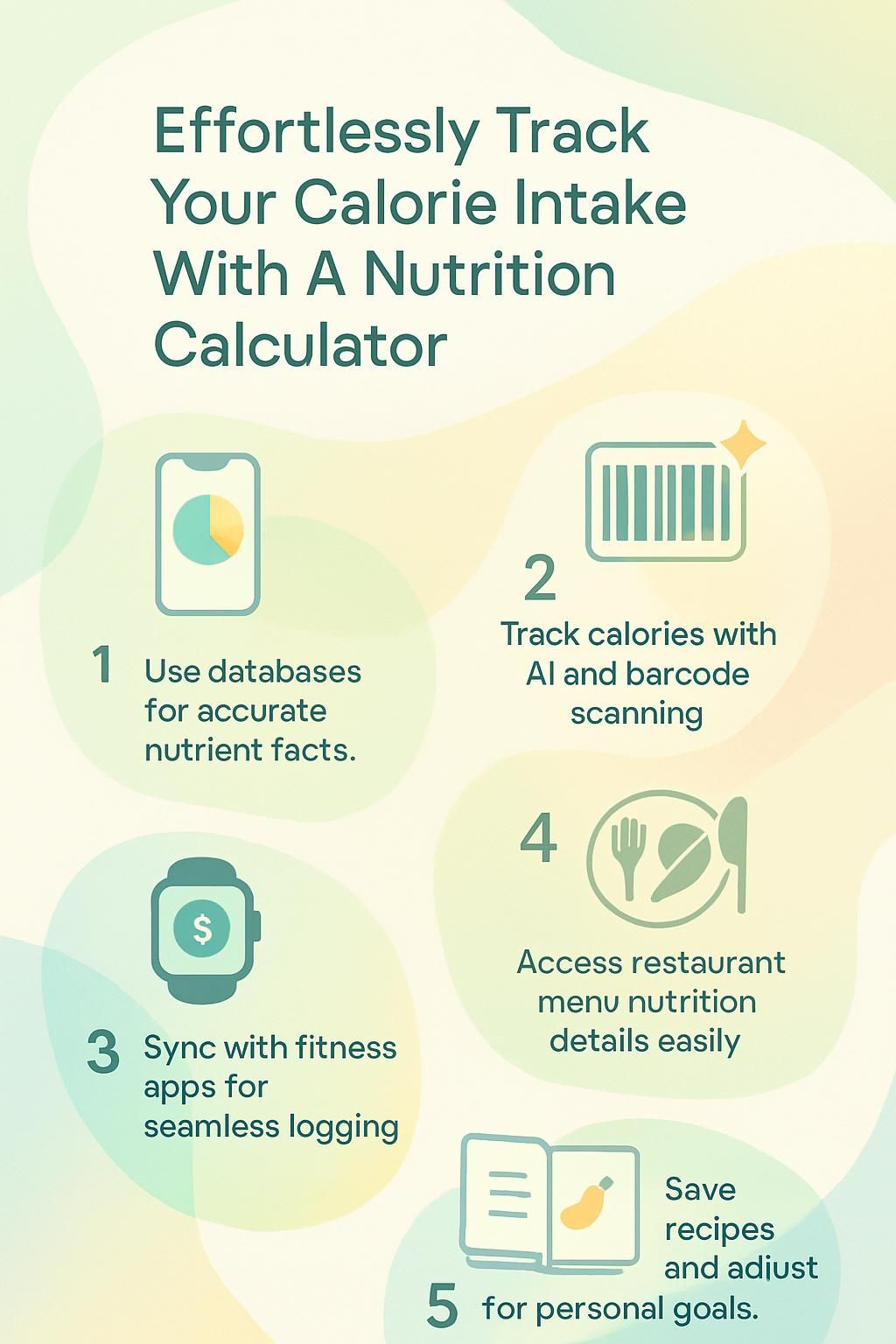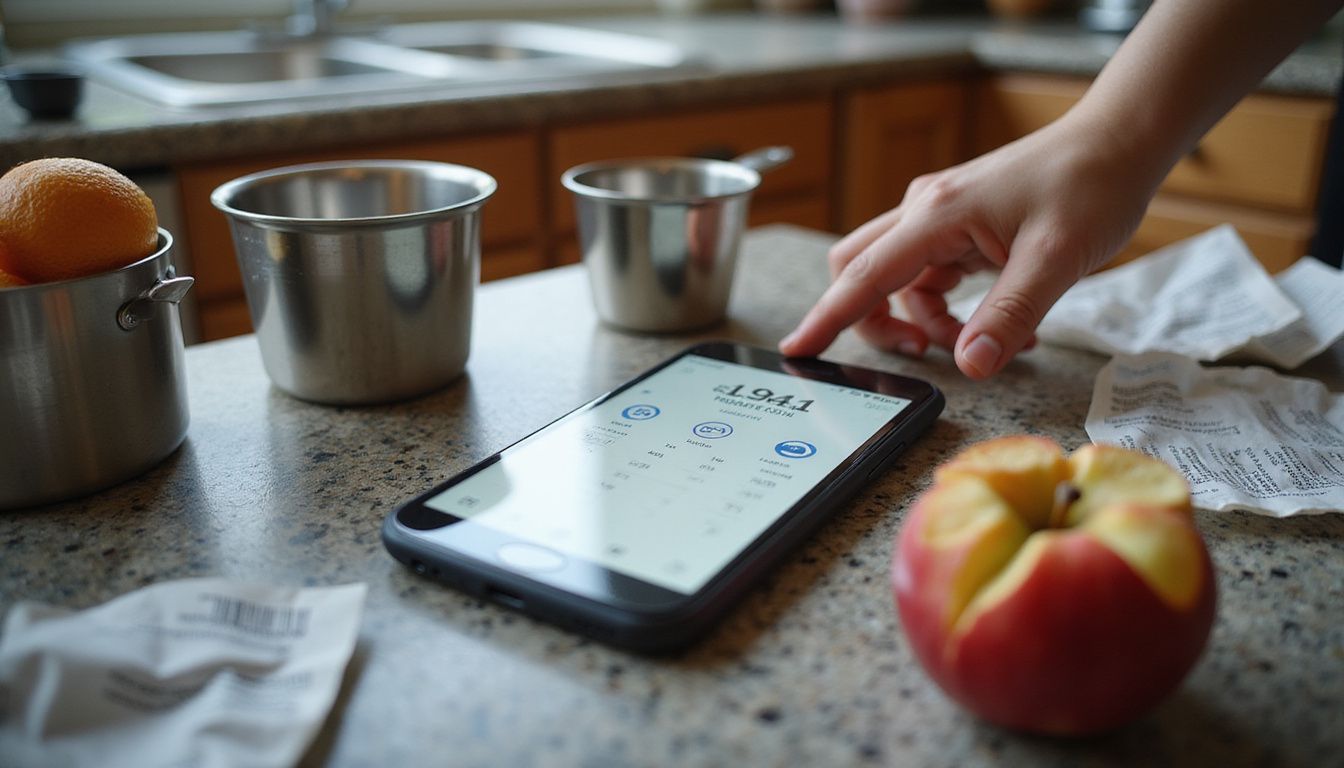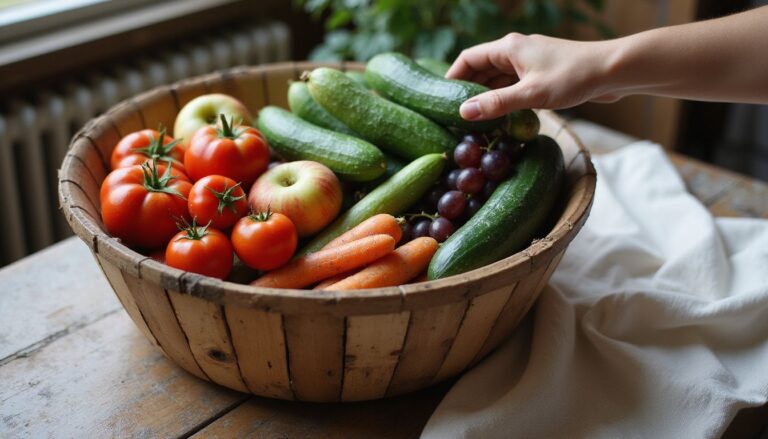Effortlessly Track Your Calorie Intake With A Nutrition Calculator
Our Nutrition Assistant AI Suite will transform your body. You will lose fat, get toned, and build muscle. Gain confidence and optimal health.
Tracking daily calories can feel confusing at first. I felt the same until I tried a nutrition calculator. This simple tool shows clear nutrition information for every ingredient and recipe, so I can plan meals with confidence.
Once I started using a nutrition calculator, I saw how small choices add up. I could compare foods, check a recipe, and adjust a serving size without guessing. That helped me improve diet quality and stay closer to my weight goals.
With a good calculator, I can calculate calorie content, create a nutrition facts label, and scan barcodes for quick entry. These features turn calorie tracking into a few clicks, not a long chore.
Take one step today. Learn how to manage what goes into your body with simple tools and see steady progress toward your goals.
Key Takeaways
- Nutrition calculators pull data from trusted sources such as the USDA National Nutrient Database, which supports accurate calories and nutrients for home recipes and restaurant meals.
- Barcode scanning, AI ingredient recognition, and instant updates make it easy to change ingredients, adjust serving sizes, and refresh your nutrition label right away.
- Many tools sync with fitness apps like MyFitnessPal for seamless logging of meals, physical activity, BMI, and daily intake.
- Restaurant calculators, including Chipotle’s, show detailed menu nutrition and current promos, such as $0 delivery fees from September 8–30, 2025, to help plan meals precisely.
- Save favorite recipes, use visual analysis to spot nutrient gaps, and tweak ingredients or portions to match your personal goals.

What Is a Nutrition Calculator?

A nutrition calculator is a website or app that analyzes foods and recipes. I use it to see calories, nutrients, and daily values for everything I eat in a day.
What does a nutrition calculator do?
The calculator builds a custom nutrition facts label for any meal or recipe. I enter each ingredient, and it lists calories, fat, carbs, fiber, protein, and other nutrients. It also compares my meal to daily targets known as Reference Daily Intake, a standard guide for nutrient needs.
It can estimate values using cooked weights, then let me save or share recipes for quick use later. I can review several recipes side by side, which helps me choose the better option fast.
Some tools also include a food tracker and simple wellness features. I can log breakfast, lunch, dinner, or a snack, including restaurant meals, and keep everything in one place.
The right nutrition calculator turns every meal into a chance to make a smarter choice.
How does a nutrition calculator work?
I type or scan each ingredient with its amount, such as “milk 120 g” or “banana 35 g.” The calculator checks a large database, then totals my calories and nutrients.
It reports macronutrients, which are protein, fat, and carbohydrates, and other key values for the whole recipe. I can choose the number of servings to see the data per portion.
Editing is easy. I click the pencil icon to change or delete an item and the results update in real time. I can also scan a UPC barcode for packaged foods, which speeds up entry.
Once I am done, I save my recipe and share the link if needed. The tool uses standard sources and my custom entries to match my nutritional needs and average daily requirement.
Benefits of Using a Nutrition Calculator
I use a nutrition calculator to track calories without stress. It helps me manage my diet and adjust for weight loss or weight gain by showing clear numbers.
How can a nutrition calculator make calorie tracking easier?
I can track calories for a single dish or a full recipe with strong accuracy. I enter each ingredient, change a serving size, or swap an item, and the total updates instantly.
For example, if I remove cheese from a sandwich, the new calorie count appears right away. Seeing the shift helps me cut fewer calories in the wrong places and focus on what matters most.
The daily intake tracker also shows trends across days. Item-level analysis points out what drives calorie spikes, which supports better choices.
How does it help improve meal planning?
A nutrition calculator helps me test and compare recipes before I cook. If I switch from whole milk to low fat milk, I immediately see the effect on calories and fat.
Features like “Analyze New Recipe” or “Start Over” make a fresh plan simple. Group order tools can build up to 15 personalized meals at once, which helps when I plan for family or friends.
Build-your-own menus work well for groups of four to six. Catering starts at $8.25 per person with a 24-hour notice, which gives me precise control over portions and nutrition data before placing an order.
These options make weekly planning clearer and faster during busy times.
How does it increase nutritional awareness?
The calculator lets me interact with my food choices. I can click or hover on a nutrition label to see how each ingredient adds to calories, protein, fat, and fiber. Labels often use the 2,000-calorie daily reference, a common guide for many Americans.
If an ingredient lacks data, the tool flags it for review. That helps me find missing nutrient details and fix them quickly.
It also shows where I meet or miss targets based on general references. Actual needs vary by age, sex, activity level, and health status, so these values are a guide, not medical advice. For a tailored plan, I seek help from a registered dietitian.
What personalized recommendations can it provide?
I enter how many servings I need and see a custom nutrition label for each person at the table. Smart swaps appear during entry, like using Greek yogurt instead of sour cream to lower calories and lift protein.
Setting the final cooked weight refines portion values. I also save recipes to track how small changes affect my intake over time.
For special diets, I create custom ingredients. That way the suggestions fit my routine and my health goals.
How does it support weight management goals?
Personalized tips guide my food choices, then the calculator helps me stay on target. The daily calorie tracker shows how close I am to my limit, such as 2,000 calories a day.
I use the BMI calculator to monitor my Body Mass Index, a simple ratio of weight to height. Real-time adjustments keep me from going over my goal.
Swapping or removing ingredients lowers a recipe’s total. For instance, moving from whole milk to skim milk cut about 40 calories per cup in my breakfast last week.
Portion control is simple because I can set serving sizes before I cook. Over time, I compare past and current logs to see progress.
Key Features of a Nutrition Calculator
Good calculators make tracking your food efficient and reliable. These features help me plan meals based on clear evidence instead of guesswork.
Ingredient-Based Analysis
I click “+Add Ingredient” to enter items by name or with a UPC scan. If the tool does not recognize an item, it highlights the field so I can adjust the amount or unit using the dropdown or the pencil icon.
Accurate ingredients lead to accurate totals. I compare similar foods to choose the better option for my goals.
Each analysis shows nutrients per serving, including protein, fat, carbohydrates, and fiber. That clear breakdown shows how each choice affects my daily intake.
Recipe Nutrition Calculation
Once I add ingredients, the calculator aggregates the data for a complete recipe view. I see calories and macronutrient details right away.
The tool displays a nutrition facts label beneath the recipe. If I need to account for water changes or cooking loss, I adjust the final weight.
For meal prep, I set servings so values update per portion. Saving a recipe lets me test versions and improve quality before I cook. Sharing through a link or an embed code makes it easy to show favorite dishes to others.
If I want a fresh start, I reset and build a new combination.
Daily Calorie Intake Tracking
Daily tracking lets me log every meal and snack. I can track a single dish or an entire day, which helps me stay consistent.
The system often uses a 2,000-calorie diet as a reference, then adjusts based on my details, such as a weight of 180 pounds.
I enter exact amounts to see totals for calories, macronutrients, and micronutrients compared to my recommended intake. That keeps my choices aligned with guidance from sources like MyPlate and the CDC.
Macronutrient Breakdown
After I log calories, I review macronutrients. These are the big three, carbohydrates, fats, and proteins. The calculator shows amounts for each item and the recipe as a whole.
For example, rice is mostly carbs and chicken breast is high in protein with very few carbs. If a nutrient is missing from any ingredient, that item is excluded from the total so the result stays accurate.
Clicking a value reveals details like fiber and sugar within total carbs. Comparing recipes helps me swap to options with less fat or more protein, based on my goals.
Integration With Fitness Apps
Connecting nutrition data to fitness apps gives me a complete picture. I sync food logs with MyFitnessPal so diet and exercise update together.
This two-way sync supports accurate calorie adjustments based on activity. I export or compare data across platforms as needed and keep serving sizes aligned so logs stay consistent.
Most recipe calculators are now compatible with popular trackers. Using the latest browser version keeps exporting and sharing smooth.
Types of Nutrition Calculators
Different calculators solve different needs. I switch between them based on whether I want a recipe view or a full-day view.
What are recipe nutrition calculators?
Recipe nutrition calculators create custom labels from user-entered recipes. They total calories, macronutrients, and micronutrients using serving sizes and ingredient weights.
I can add, edit, or remove items anytime. If the tool cannot find something, it asks me to correct or substitute it.
I save each recipe in my personal list and share or embed the label if I want. Recipe calculators help me understand home-cooked meals before I move to daily tracking.
What are daily nutrition calculators?
Daily nutrition calculators track what I eat across the whole day. I log meals and snacks to see my totals in real time.
The tool compares my intake with standard recommendations from the USDA. It also highlights where I meet or miss goals.
If I fall short on vitamins or minerals, I get feedback to adjust the next meal. Keeping a daily record has helped me stay consistent with weight targets.
How do restaurant nutrition calculators work?
Restaurant calculators give nutrition for specific menu items from well-known brands. For example, I checked Chipotle’s Carne Asada Burrito Bowl with guacamole using their tool. It showed calories, protein, fat, carbs, and sodium based on current kitchen data.
These tools help me compare items across fast food or casual dining in seconds. Some restaurants, including Chipotle, also display promos like $0 delivery from September 8 to 30, 2025, for orders of $10 to $200 before tax. Menu prices may be higher online and service fees often apply.
Using these tools gives me reliable facts on the spot, which leads to better choices.
What are BMI and nutrition consultation apps?
BMI and nutrition consultation apps estimate Body Mass Index, a height and weight measure, then provide personalized recommendations. Many include recipe analysis and food trackers.
I use them to check BMI, daily calories, and macronutrient balance. These features support weight goals with clear labels and simple planning tools, which helps with both short-term habits and long-term changes.
How to Use a Nutrition Calculator Effectively
Learning a few steps makes calorie tracking faster and more accurate.
How do you input ingredients for recipes?
I search for an ingredient and add the weight in grams or ounces. For packaged items, I scan the UPC barcode to speed things up. If an item is missing, I click “+Add Ingredient” and enter the details.
The pencil icon lets me edit or remove items. If the tool flags an entry, I confirm the correct name, amount, or unit before moving on.
I pick the number of servings to get accurate per-portion results. Adjusting the final cooked weight matters because moisture change affects calories and nutrients. When I finish, I hit “Save to your recipes” to use it later.
How to track meals and snacks accurately?
I log meals and snacks as I eat them. Recording right away keeps my data honest. I set exact amounts and serving sizes so the numbers match what I actually ate.
If my meal changes, I delete or edit items with a single click. Real-time updates let me check calories, macros, and portion details for each entry.
I can share recipe logs with a URL for accountability. Group orders, up to 15 meals, allow everyone to pick their own version, and organizers can handle payments and make sure each choice gets logged.
This routine gives a true picture of my daily intake and supports steady progress.
How to analyze nutritional gaps in your diet?
I compare my daily totals to standard guidelines for a 2,000-calorie diet. The calculator points out low areas, like iron or fiber.
Hovering over a nutrient shows which foods contributed most. If my protein is below my target, I swap or add foods to raise it. I review each recipe to see if it supports both macro and micronutrient needs before adding it to my plan.
How to adjust intake based on your goals?
To reach calorie or nutrient targets, I change quantities and serving sizes inside the calculator. For weight goals, I use the BMI tool to track trends and tune my daily intake.
If I need fewer calories, I swap in lower calorie items, like zucchini noodles for pasta or grilled chicken for fried. For protein goals, I choose recipes with more lean meat or plant proteins and compare options.
Real-time updates help me stay on track as goals shift. Saving recipes lets me measure progress across weeks and months.
Setting final weight and water change improves accuracy for cooked foods. I fine-tune vitamins and minerals based on lab results or a dietitian’s advice.
Popular Nutrition Calculator Tools
Reliable tools use research-based methods and large databases. I use them to plan meals, measure my intake, and check progress.
What is the MyPlate Plan Calculator?
MyPlate Plan Calculator uses the USDA National Nutrient Database and aligns with federal dietary guidelines. It often bases examples on a 2,000-calorie day, then adapts for personal details like age and activity.
For someone who weighs 180 pounds, it provides daily calorie and nutrient ranges that support balanced meal planning. I compare my analysis to MyPlate guidance to keep my meals grounded in credible advice.
What are the best recipe nutrition calculator apps?
Recipe Nutrition Calculator tools let me enter standard or custom ingredients, set servings, final weight, and note cooking changes. I can view an illustrated label for each recipe and spot errors fast.
Apps like Verywell Fit Recipe Nutrition Calculator also support comparisons, so I can optimize meals for my goals. I often save or embed labels online for easy sharing.
Most platforms update data often. They also work best on current versions of major browsers, not Internet Explorer. Seeing a macronutrient breakdown and editing recipes before I cook makes calorie tracking simpler.
How do fitness app integrations like MyFitnessPal work?
Many recipe calculators connect to tracking platforms like MyFitnessPal. I sync my meals and snacks so my daily totals update across devices without double entry.
The app exports recipes, serving sizes, and nutrition facts to my fitness dashboard. If I change a serving size in MyFitnessPal, the connected calculator reflects the change almost right away.
Using an up-to-date browser improves sync speed and stability between tools.
What restaurant-specific calculators are available (e.g., Chipotle, Taco Bell)?
Chipotle’s calculator lets me customize a meal and see calories and macronutrients immediately. I can select Carne Asada in a Burrito Bowl with guacamole and check calories, protein, carbs, fat, sodium, and fiber.
It also shows promotions, such as $0 delivery for Carne Asada from September 8 through September 30, 2025. Build-Your-Own options for four to six people include $10 off first-time orders with code TRYBYOC between August 26 and October 21 or until 500000 redemptions.
Taco Bell’s calculator offers a similar build-and-check approach. Both tools update values live based on toppings and swaps. Students using Chipotle U Rewards can earn 1000 bonus points, and catering starts at $8.25 per person for groups of six to two hundred with 24 hours’ notice.
Advanced Innovations in Nutrition Calculators
New features add speed and accuracy, which makes healthy choices easier to act on.
What is AI-powered ingredient recognition?
AI ingredient recognition uses machine learning to identify foods and their nutrients. I scan a UPC barcode to auto-fill details and cut down on typing.
If the system detects an error, it asks me to pick the correct item from a list. A unit converter helps when a measurement does not match a standard unit.
The platform flags missing data as I type. AI suggestions appear to complete the analysis with less effort. Clicking “+Add Ingredient” stays quick, and totals update the moment I make a change.
How do real-time calorie adjustments work?
Swapping ingredients refreshes calories and nutrients almost instantly. If I replace whole milk with almond milk in a smoothie, the label changes right away.
I can edit or delete items and see updated totals in both the label and macro view without delay. Changing serving sizes triggers fresh numbers for calories, protein, carbs, and fat.
Adjusting the final recipe weight recalculates totals too. These fast updates help me hit targets like 1,800 or 2,200 daily calories. The same quick changes work in apps such as MyFitnessPal.
What are visual nutritional analysis tools?
Visual tools show a nutrition label right under each recipe. Color cues and icons highlight which ingredients add most to calories, macros, and key micronutrients.
Clicking a nutrient opens a deeper view, which shows where protein, fat, carbs, and vitamins come from. Side-by-side comparisons make sodium or fiber differences easy to see without scanning long tables.
Color-coded gaps point out low iron or vitamin D quickly. These visuals guide better meal choices without needing advanced nutrition training.
How do community features support shared recipes?
I can save and share recipes with a URL or an embed code so friends can try them or customize them. Group orders let each person personalize a meal, up to 15 meals per order, which simplifies events or busy weeks.
Organizers handle payments and logistics. Shared recipes let our group compare nutrition values and learn from each other’s choices. Student rewards, such as Chipotle U, can make group orders more appealing.
Seeing how others build balanced plates has helped me spot gaps in my own plan.
Tips for Choosing the Best Nutrition Calculator
Choosing the right tool depends on your goals, your schedule, and the device you use most.
How to assess your goals and needs?
I decide whether I want to lose, maintain, or gain weight. The BMI calculator shows how my current numbers compare to healthy ranges, then I set daily calorie and macronutrient targets based on official guidance.
If I eat out a lot, I rely on restaurant calculators. If I cook at home, I use recipe analysis to track ingredients and adjust serving sizes for precise labels.
What makes a nutrition calculator user-friendly?
Simple search, add, edit, and delete functions matter most. Clear error messages help fix ingredient or measurement issues fast.
Visual tools and illustrated labels make it easy to understand calorie intake and nutrient breakdown at a glance. Saving, sharing, and embedding recipes in a few clicks is a plus.
Support for standard and custom ingredients adds flexibility. Group order options help with family planning or events, and quick customer support prevents delays. Most sites run smoothly on modern browsers but not on Internet Explorer.
Why look for comprehensive databases?
Comprehensive databases improve accuracy. The USDA National Nutrient Database includes thousands of foods, with both macro and micronutrients.
With a broad database, I can analyze recipes precisely, scan UPC codes, and enter custom foods when needed. Including restaurant items is helpful if I eat out often.
Regular updates keep data current. If something is missing, the system flags it so I can correct it right away.
How to ensure compatibility with your devices?
I make sure the calculator works on both desktop and mobile. I keep Chrome, Firefox, or Safari up to date. Internet Explorer is not supported by most platforms.
For sharing across devices, I use a simple URL and the same account. Fitness app integrations like MyFitnessPal depend on permissions and a stable connection.
Enabling JavaScript ensures pages load correctly. If issues come up, I check the site’s compatibility page for fixes.
Conclusion
Using a nutrition calculator made calorie tracking part of my routine. With accurate data, I can manage recipes, set serving sizes, and align daily choices with my goals.
Trusted databases and real-time updates reduce guesswork and support better planning. These tools help me stay aware of what I eat, make healthier choices, and move forward at a steady pace.
Educational only, not medical advice. For personal guidance, consult a registered dietitian or healthcare professional. Sources: USDA FoodData Central and U.S. Dietary Guidelines, Centers for Disease Control and Prevention.
FAQs
1. How does a nutrition calculator help track calorie intake?
A nutrition calculator allows users to log foods and beverages, then calculates total calories consumed each day. This tool uses verified food databases for accurate results, helping individuals manage their energy balance effectively.
2. What data do I need to use a nutrition calculator accurately?
Users should enter specific details such as portion size, preparation method, and brand or type of food item. Accurate input ensures reliable calorie counts and nutrient breakdowns.
3. Are the results from a nutrition calculator reliable?
Most reputable calculators rely on established sources like the United States Department of Agriculture FoodData Central database or peer-reviewed nutritional studies for their information (USDA, 2023). Consistent use improves awareness of eating habits; however, actual needs may vary based on age, activity level, and health status.
4. Can using a nutrition calculator improve my dietary choices?
Tracking with a nutrition calculator can reveal patterns in eating behavior that might otherwise go unnoticed. For example, after logging meals over several weeks during my own weight management plan, I noticed frequent high-calorie snacks between lunch and dinner contributed most to daily excesses. Recognizing these trends made it easier to adjust meal planning for better outcomes.
Summary: Nutrition calculators provide evidence-based support for tracking calorie intake by combining user-entered data with trusted nutritional resources. Regular use helps identify areas needing change while supporting informed decisions about diet quality and quantity.







